Excerpts from Jim Conrad's
Naturalist Newsletter
entry from field notes dated January 19, 2023, taken in disturbed areas and along Hwy 120 on the north and east side of town, elevation ±2,380m (7600 ft); bedrock of Cretaceous limestone, in the Eastern Sierra Madre mountains; walking distance of Pinal de Amoles, Querétaro state, MÉXICO,(N21.137°, W99.622°)
VALERIANA CLEMATITIS
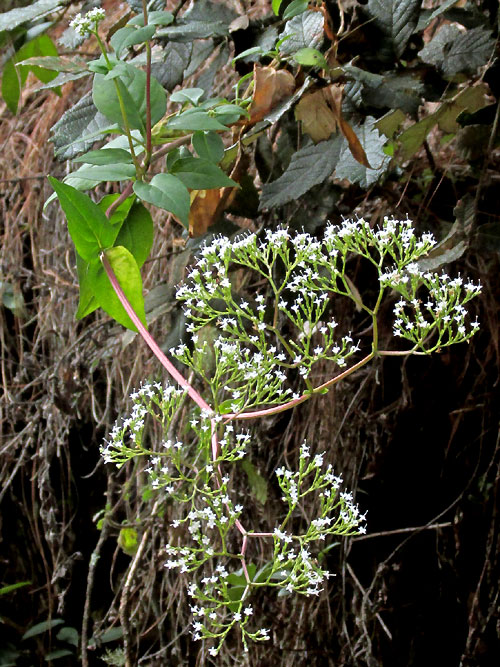
On the northwest side of Pinal de Amoles, beside Hwy 120, the above handsome inflorescence dangled from its semiwoody bush rooted above an old roadcut. Note that the leaves arise in pairs, opposite one another along the stem, better shown below:
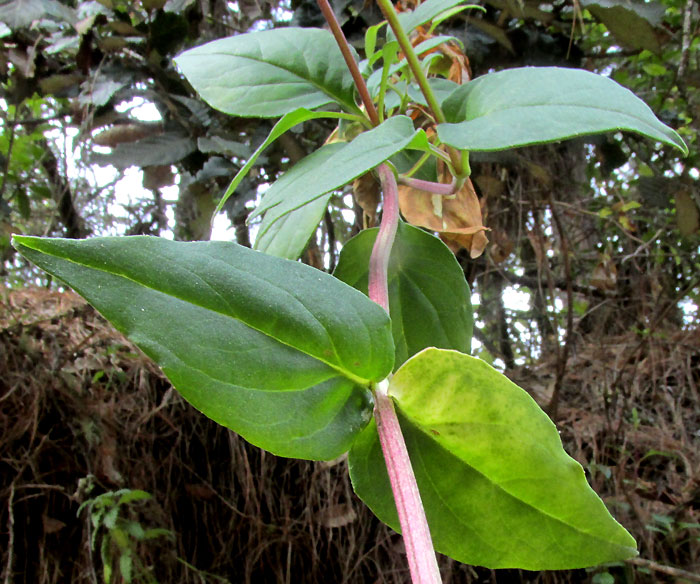
The leaves have short petioles near the inflorescence, but the petioles grow longer toward the bush's base. Below, my hand as scale indicates the size of things:
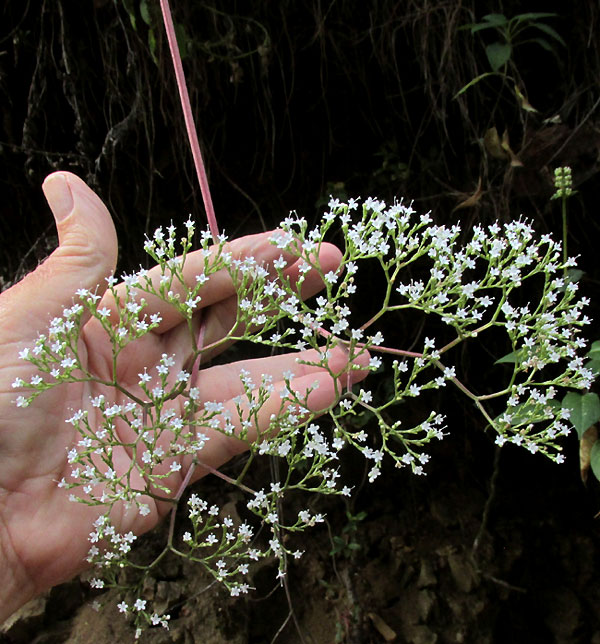
This inflorescence type is described as corymbiform. A corymb in an inflorescence with flowers forming a flat or curved surface, with the inflorescence's outermost flowers arising on longer stalks, or pedicels, so that all flowers appear at a common level. This can be observed better below:
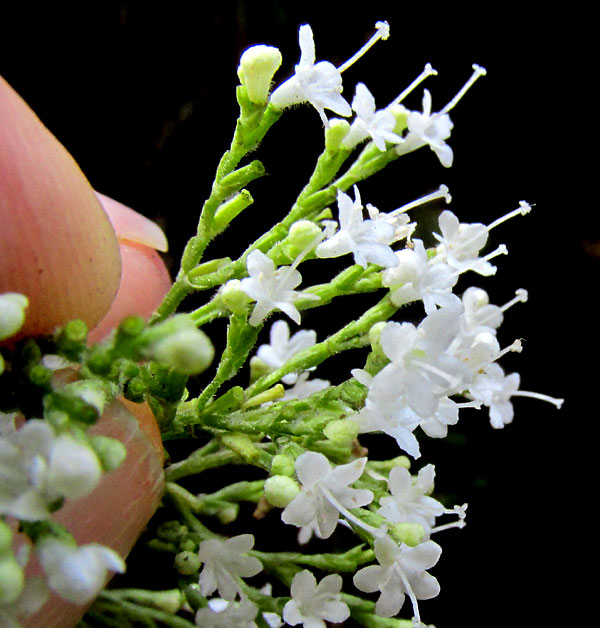
Above, notice that just below each open blossom there's the developing ovary -- the future fruit -- which has shed its corolla after the flower was pollinated. This corymbiform inflorescence is still expanding, as outermost flowers get pollinated, lose their corollas, and new flowers open up above them.
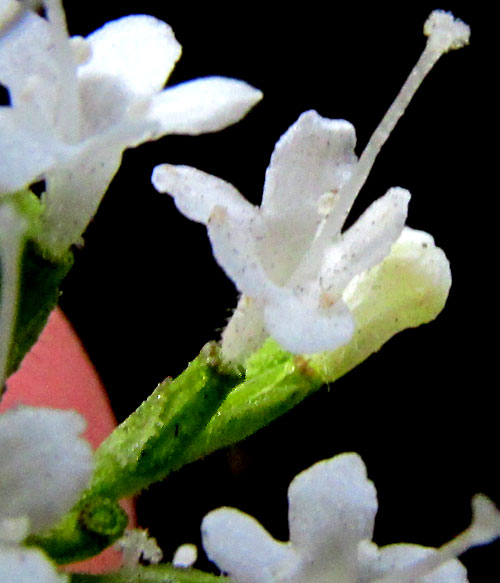
The most diagnostic feature seen on the above flower is that the corolla and stamens arise above the ovary, so this flower has an inferior ovary, which disqualifies our plant from belonging to a large number of plant families with superior ovaries. A peculiarity of our plant is that its calyx is reduced to the barely discernible, bumpy "ring" surrounding the corolla, at the ovary's top. Later each bump will unfurl into a feather-like appendage atop the fruit, enabling wind dispersal. Looking at the flower now, you'd never guess what would happen; you just must know which plant this is, and that in the genus it belongs to, that's how the calyx behaves.
The flowers are described as gynodioecious, which means that some plants produce flowers with both male and female parts, while other plants of the same species bear only female flowers. In the above photo, the flower's three white stamens are hard to see inside the white corolla, but they're present, the one best seen peeking from behind the style. However, in this species the stamens are described as extending well beyond the corolla, so probably our inconspicuous stamens are vestigial and sterile, and our plant just produces female flowers.
With such good field marks, especially the large corymbiform inflorescence at the tip of a ground-hugging or dangling branch of a semiwoody bush with opposite, undivided leaves, and producing gynodioecious flowers with inferior ovaries, we can figure out that our plant belongs to the fairly large genus Valeriana. In English the 420 or so worldwide species of Valeriana commonly are known as valerians. As a young naturalist I learned that a special feature of valerians was that they tend to branch dichotomously -- a stem branches into a Y, then the branches of the Y branch to form another Y, etc. You can see that in the above inflorescence photos. Also I learned that valerians, when they're dried and pressed for herbarium specimens, stink like unwashed socks.
Also I learned that valerians were members of the Valerian Family, the Valerianaceae, but now genetic studies indicate that the Valerian Family is "nested" inside the Honeysuckle Family, the Caprifoliaceae, so the Valerian Family has been lumped into the Honeysuckle Family. Our plant's flowers are very similar to those of certain viburnums, members of the Honeysuckle Family, so maybe the change isn't as strange as it seems.
In the 2003-published Flora del Bajío treatment of the old Valerian Family as represented in our upland part of central Mexico, twelve species of the genus Valeriana are described. Using the Flora del Bajío, if you have a Valeriana with stems reclining on the ground or dangling, the stems bear simple leaves during the flowering period, and the flowers are gynodioecious, then your plant is said to be Valeriana subincisa.
However, if you look up that name on Kew's Plants of the World Online database, you're told that nowadays Valeriana subincisa has been made a synonym of Valeriana c, the latter having precedence. However, the equally authoritative GBIF.org database at this writing accepts the name Valeriana subincisa. On the Internet, more institutions seem to be using V. clematitis than V. subincisa, so I'll go with VALERIANA CLEMATITIS. This is an example of the ever-changing state of confusion genetic sequencing has brought us.
While Valeriana subincisa was said to exist from upland Mexico south into Guatemala, Valeriana clematitis is described as appearing from Mexico south to Argentina. In Mexico our plant is regarded as fairly frequent to abundant in various forest types at 1250-2800m (4100-9200ft) elevation.
The online 2008 publication entitled Vademécum Colombiano de Plantas Medicinales -- medical plants of Colombia -- reports that in Colombia the roots, rhizomes and stolons of our plant (under the name of Valeriana pavonii, another synonym) are used to treat nervous problems associated with anxiety, insomnia and convulsions. Presumably a tea is made by cooking the underground parts. In fact,since ancient Greek and Roman times, the underground parts of species of Valeriana, especially the Old World Valeriana officinalis, have been used as a sedative, often sold as "valerian root." The WebMD.Com website describes valerian root as possibly effective, adding that when taken by mouth "Valerian is likely safe when used short-term. Valerian has been used safely in doses of 300-600 mg daily for up to 6 weeks. The safety of long-term use is unknown."
Entry dated April 19, 2024, from notes taken about 1.5km northeast of Puerto de los Velazquez, Municipality of Pinal de Amoles; N21.138°, W99.665°, elevation ~2780 meters (~9120 feet); oak/pine forest on limestone bedrock; in the Eastern Sierra Madre Mountains of east-central Querétaro state, MÉXICO
ANOTHER APPEARANCE OF VALERIANA CLEMATITIS
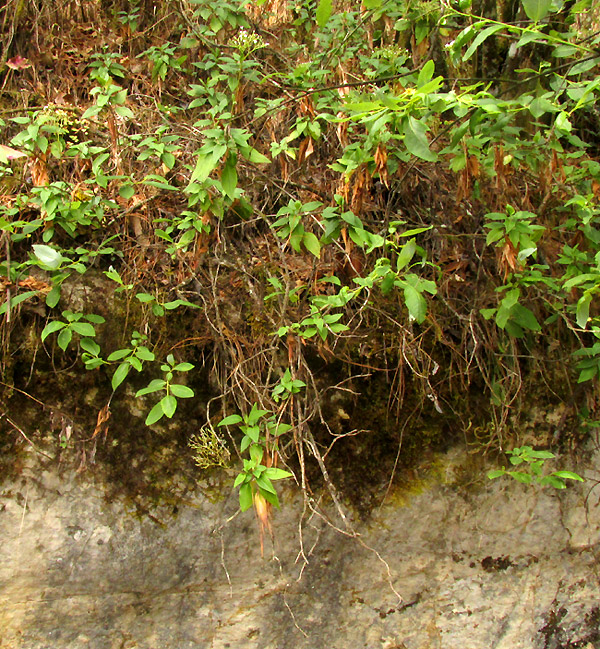
At a distance, the plant shown above looked very similar to the previously documented one, especially its location atop an old roadcut.
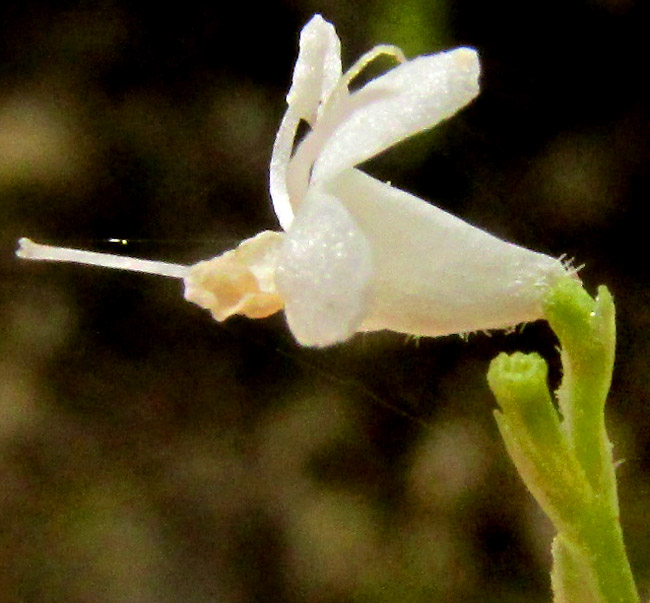
This time I got a better side view of a flower, showing how the style extends well beyond the funnel-shaped corolla.
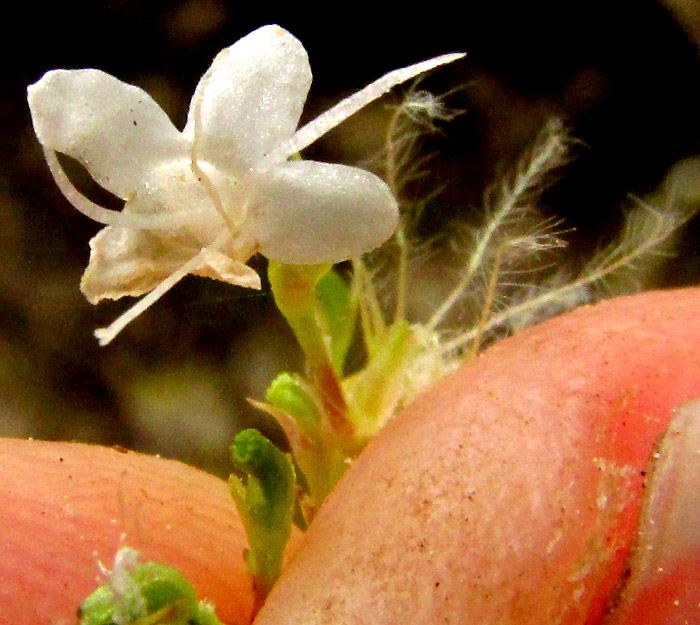
The lowest of the above blossom's corolla lobes is withered for unknown reasons. Valeriana flowers produce three stamens, but on the above flowers the three stamens' slender, white filaments bear no pollen-producing anthers. Valeriana clematitis flowers are said to be gynodioecious. That means that the species uses a somewhat rare breeding system in which certain plants bear only female flowers, while the flowers of other plants produce both male and female parts. Though sometimes animals eat a flower's stamens, I suspect that the above is a functionally female flower on which the anthers naturally aborted.
Gynodioecy is regarded as an evolutionary intermediate stage between species whose plants produce individuals bearing only male or only female flowers, or else individuals with flowers developing both male and female parts. Flowers with both male and female parts are thought to be the primitive state, and unisexual flowers a more recent innovation.

The above picture was meant to be cropped so that only the flower was included; not seeing so well, I thought the fuzzy stuff in the background was a feathery-topped Mountain Mahogany fruit, for such a tree disseminating its fruits stood nearby. As shown at the right, later it was realized that the fuzziness consisted of feathery calyx lobes normally arising atop the fruits of Valeriana species. In the fruit picture, most fruits, the younger ones, display no feathery calyx lobes. The Flora del Bajío says that, in flowers of Valeriana species, feathery calyx segments atop the ovaries are rolled into a ring. Once the ovary becomes a mature, one-seeded, achene-type fruit, the calyx segments unfurl, as seen in the picture. notice that fruits without unfurled calyx segments appear to be knobbed at their tops; the knobs must be the rings.
Is it just a coincidence that two plants belonging to two different families appearing together both disseminate their propagules with feathery structures? Our windy mountaintop explains why parachute-like feathery structures might help the seeds be disseminated. Also, our plants occupy a borderline cloud-forest situation often visited with cloud-fog. Water droplets were seen condensed on the Mountain Mahogany's feathery fruit barbules, so maybe the added moisture helps fruit and seed develop?

On our previously documented Valeriana clematitis, the leaves grew mostly or entirely in pairs opposite one another. Above, our plant's leaves appeared singly at each stem node. The Flora del Bajío describes the habit of Valeriana clematitis as usually lying on the ground and producing stolons, but also forming masses of twisting stems to 2m tall (7ft), and yet other times climbing up to 10m high (33ft).
Our Valeriana clematitis is a plant of variable appearance.